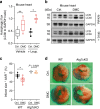The flavonoid 4,4'-dimethoxychalcone promotes autophagy-dependent longevity across species
- PMID: 30783116
- PMCID: PMC6381180
- DOI: 10.1038/s41467-019-08555-w
The flavonoid 4,4'-dimethoxychalcone promotes autophagy-dependent longevity across species
Abstract
Ageing constitutes the most important risk factor for all major chronic ailments, including malignant, cardiovascular and neurodegenerative diseases. However, behavioural and pharmacological interventions with feasible potential to promote health upon ageing remain rare. Here we report the identification of the flavonoid 4,4'-dimethoxychalcone (DMC) as a natural compound with anti-ageing properties. External DMC administration extends the lifespan of yeast, worms and flies, decelerates senescence of human cell cultures, and protects mice from prolonged myocardial ischaemia. Concomitantly, DMC induces autophagy, which is essential for its cytoprotective effects from yeast to mice. This pro-autophagic response induces a conserved systemic change in metabolism, operates independently of TORC1 signalling and depends on specific GATA transcription factors. Notably, we identify DMC in the plant Angelica keiskei koidzumi, to which longevity- and health-promoting effects are ascribed in Asian traditional medicine. In summary, we have identified and mechanistically characterised the conserved longevity-promoting effects of a natural anti-ageing drug.
Conflict of interest statement
D.C-G., G.K., O.K. and F.M. are the scientific co-founders of Samsara Therapeutics. The remaining authors declare no competing interests.
Figures







Comment in
-
Targeting GATA transcription factors - a novel strategy for anti-aging interventions?Microb Cell. 2019 May 6;6(5):212-216. doi: 10.15698/mic2019.05.676. Microb Cell. 2019. PMID: 31114793 Free PMC article.
-
4,4'Dimethoxychalcone: a natural flavonoid that promotes health through autophagy-dependent and -independent effects.Autophagy. 2019 Sep;15(9):1662-1664. doi: 10.1080/15548627.2019.1632623. Epub 2019 Jun 28. Autophagy. 2019. PMID: 31248332 Free PMC article.
References
Publication types
MeSH terms
Substances
Grants and funding
LinkOut - more resources
Full Text Sources
Other Literature Sources
Medical
Molecular Biology Databases

